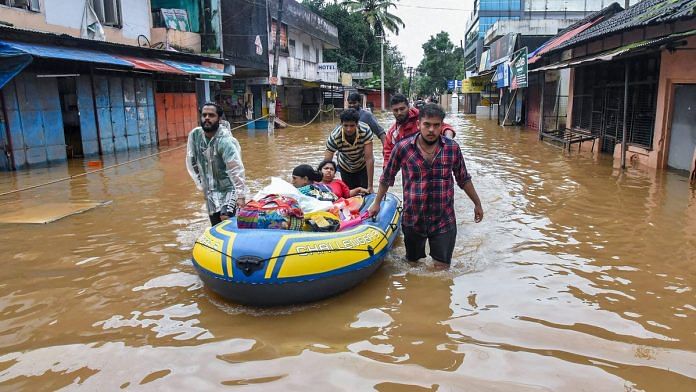From not informing people in time to not replacing faulty detection equipment, a series of govt errors resulted in the large-scale devastation in Kerala.
New Delhi: A report by a team of researchers from the Jawaharlal Nehru University (JNU) has blamed the state government for the devastation caused by the Kerala floods, saying it did not act on time to combat this “man-made disaster”.
JNU’s Special Centre for Disaster Research said the state did “not deal with the situation in an appropriate manner”. It said the government did not inform people in time about the impending disaster — even though the state had issued ‘red’ and ‘orange’ alerts about the flood in time, the common public didn’t know the meaning of these signs, and so could not act in time.
‘Orange’ level weather warnings tell people that they should prepare for an impending disaster, while a ‘red’ alert implies that people should start taking action by moving their families out of the affected zone temporarily.
The report has been prepared by Prof. Amita Singh, Prof. Sunita Reddy, Gaurika Chugh and Dr Monika Kamthan. The team surveyed the four worst-hit districts — Idukki, Alappuzha, Pathanamthitta and Kottayam.
Also read: Kerala floods: This is what Kochi has to do to avoid drowning again
The report will be officially released on 26 October, and the team is likely to ask for strict action against the disaster management authorities in Kerala for flouting norms.
Opening Idukki Dam’s gates
The report also criticised the opening of five gates of the Idukki Dam at the same time, without having an estimation of the kind of impact it could have on the rising water levels in the state, which was already receiving excess rainfall.
“The Dam Management Authority and Kerala State Disaster Management Authority had no coordination on opening the gates of the dam and controlling the flow of water,” the report stated.
It also blamed the failure to gauge the flood situation on faulty devices installed under the Idukki Dam. The report quoted a 2014 CAG report as saying that the device had been non-functional since the time it was installed.
“Better management of dams could have reduced or diminished the devastation that occurred,” said Prof. Amita Singh said.
Also read: Understanding the 42-year-old Idukki dam which is now saving Kerala
No warnings to panchayats
Singh added that district magistrates did not warn panchayats about the impending disaster.
“Not a single panchayat that we came across in the villages we surveyed said it had an early warning about the water being released from dams,” she said.
“The Panchayat told us that one meeting with the magistrate was held on 18 July and another was held on 28 July, and in those meetings, they were told that dam gates had to be opened. But when and how many? They had no idea. Had these people been informed on time, the devastation could have been controlled.”
Also read: Had it not been for its IAS officers, Kerala’s flood damage would have been worse
Not heeding warnings
It’s not as though the disaster came out of the blue. Experts had been warning the state for years that it was on the edge of a calamity. Singh said she herself had warned the state to brace itself in a paper published in the Economic and Political Weekly in 2016.
“In the last five years, Kerala was already on a very bad land use pattern. People were removing forests for rubber plantation and coffee plantation and there were big estates of hundreds of acres of land which are very sensitive,” she said.
“The whole area which was prohibited and declared ‘no construction area’ by Madhav Gadgil saw rampant construction. They removed all the mangroves from these places and whatever is left is occupied by private owners. This made Kerala prone to disaster.”







Amita Singh who headed this study has no credibility or expertise in the field of disaster studies. Her preposterous commentary during the time of floods was torn apart with facts.
https://www.newsclick.in/kerala-floods-2018-fact-check
Why should anyone buy her claims? Let her publish the raw data based on which she made the report before I invest a second of my life reading the report.
They should clarify a number of points. 1. If rubber trees are planted after clearing a forest, in which way does it contribute to flooding? 2. How does mangrove clearance add to flooding? 3. This year’s flood was the severest after the 1922 floods. There are so many variables relating to possible flooding. How much rainfall is taking place in different catchment areas of a river. What is the possible rate of clearance of flood waters to the sea taking into account the high tide and the strength of waves. What is the flow of river at different points. Could all these factors have been predicted for flood level that had not been seen after 1922? I think these people are only self-styled experts with little knowledge of scientific processes.
Naxalite University blaming Communist kerala government is welcome.